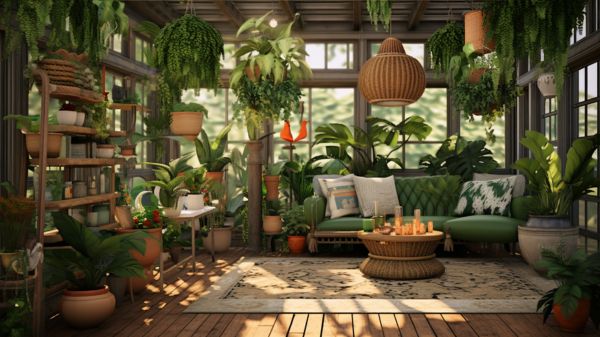Why Opt for Low-Maintenance Indoor Plants?
They say, ‘Less is more,’ and when it comes to indoor plants, we couldn’t agree more. Opting for low-maintenance indoor plants is a wise choice for all of us who seek a sense of belonging in our homes.
These green companions not only bring life and beauty to our living spaces but also require minimal effort to thrive. With busy schedules and demanding lives, we yearn for a sense of tranquility and simplicity in our surroundings.
Low-maintenance indoor plants, such as succulents, snake plants, ZZ plants, pothos, and peace lilies, provide just that. They are resilient, forgiving, and adaptable, allowing us to effortlessly create a cozy and inviting atmosphere in our homes without the stress of constant care.
So let’s embrace the serenity of low-maintenance indoor plants and find our place of belonging in nature’s embrace.
Succulents
Succulents require minimal care and thrive indoors with little effort. These resilient plants are ideal for small spaces, making them a popular choice for urban dwellers seeking to bring a touch of nature into their homes.
One of the key benefits of succulents in small spaces is their ability to store water in their leaves, stems, and roots, allowing them to survive in dry conditions. This characteristic also makes them suitable for low light conditions, as they can adapt to thrive with limited sunlight.
When caring for succulents in low light, it’s important to choose varieties that are specifically suited for these conditions and to avoid overwatering, as this can cause the roots to rot.
Snake Plants
Another low-maintenance indoor plant option that’s worth considering is the snake plant. Snake plants, also known as Sansevieria, aren’t only aesthetically pleasing but also offer several benefits for air purification. These plants have the ability to remove toxins such as formaldehyde, benzene, and xylene from the air, making them an excellent choice for improving indoor air quality. Additionally, snake plants are known for their ability to convert carbon dioxide into oxygen at night, making them ideal for bedrooms.
When it comes to propagating snake plants effectively, the best method is through division. To propagate, gently remove the plant from its pot and separate the healthy, well-established sections. Ensure that each section has its own root system. Once divided, plant the sections in separate pots with well-draining soil. Water sparingly and place the pots in a well-lit area. With proper care, the newly propagated snake plants will grow and thrive, providing both aesthetic appeal and improved air quality.
ZZ Plants
The ZZ plant is a low-maintenance indoor plant option that offers both aesthetic appeal and air-purifying benefits. If you’re considering adding a ZZ plant to your indoor space, here are some key benefits and care tips to keep in mind:
Benefits of ZZ Plants:
- Air purification: ZZ plants are known for their ability to remove toxins from the air, making them a great choice for improving indoor air quality.
- Low light tolerance: ZZ plants can thrive in low light conditions, making them ideal for spaces with minimal natural light.
- Drought tolerance: These plants have thick, fleshy leaves that store water, allowing them to withstand periods of drought.
How to care for ZZ Plants:
- Water sparingly: ZZ plants prefer dry conditions, so it’s important to avoid overwatering. Allow the soil to dry out between waterings.
- Moderate indirect light: While ZZ plants can tolerate low light, they still need some indirect light to thrive. Place them near a window with filtered light.
- Avoid cold drafts: ZZ plants are sensitive to cold temperatures, so keep them away from drafty areas.
Pothos
Continuing from our previous discussion on ZZ Plants, let’s now explore the benefits and care tips for Pothos, a popular low-maintenance indoor plant.
Pothos, scientifically known as Epipremnum aureum, isn’t only aesthetically pleasing but also offers numerous benefits for indoor air quality. These plants are excellent at purifying the air by removing toxins such as formaldehyde, benzene, and xylene.
In addition, Pothos plants are relatively easy to propagate, making them a great choice for beginners. To propagate Pothos, simply take a cutting with at least two nodes and place it in water or soil. Wait for roots to develop and then transfer the cutting to a pot.
Pothos plants thrive in indirect light and require watering only when the top inch of soil is dry. With their air-purifying qualities and ease of propagation, Pothos plants are a fantastic addition to any indoor space.
Peace Lilies
Let’s now explore the benefits and care tips for Peace Lilies, a low-maintenance indoor plant option.
Peace Lilies not only add beauty to our living spaces but also offer several benefits in improving indoor air quality. Here are three reasons why you should consider having Peace Lilies in your home:
- Air purification: Peace Lilies are known for their ability to remove harmful toxins, such as formaldehyde and benzene, from the air, making it cleaner and healthier for us to breathe.
- Humidity regulation: These plants release moisture into the air through their leaves, helping to increase humidity levels, which is especially beneficial during dry winter months or in air-conditioned spaces.
- Stress reduction: Studies have shown that being around plants, including Peace Lilies, can help to reduce stress and promote a sense of calm and well-being.
To care for your Peace Lilies and promote their growth, follow these tips:
- Place them in bright, indirect light, away from direct sunlight.
- Keep the soil slightly moist, but not soggy, and avoid overwatering.
- Fertilize them once a month during the growing season with a balanced houseplant fertilizer.
Conclusion
In conclusion, opting for low-maintenance indoor plants may seem like a foolproof way to bring nature into our lives without the hassle. However, the irony lies in the fact that these plants, touted as easy to care for, still require our attention and nurturing.
So, while they may not demand constant care, they remind us that even low-maintenance plants thrive with a little love. So let’s embrace the irony and enjoy the benefits of greenery in our lives, effortlessly.






